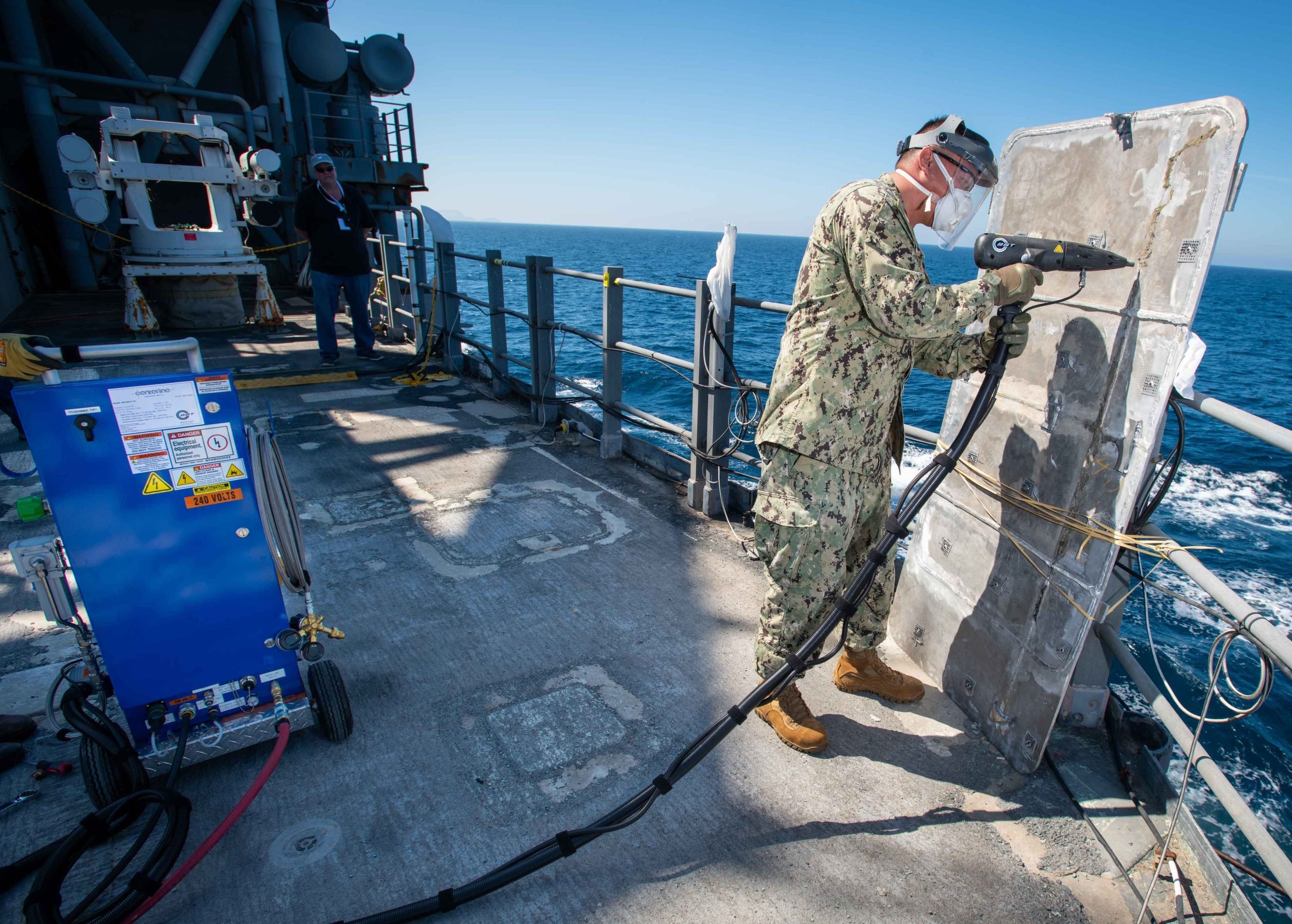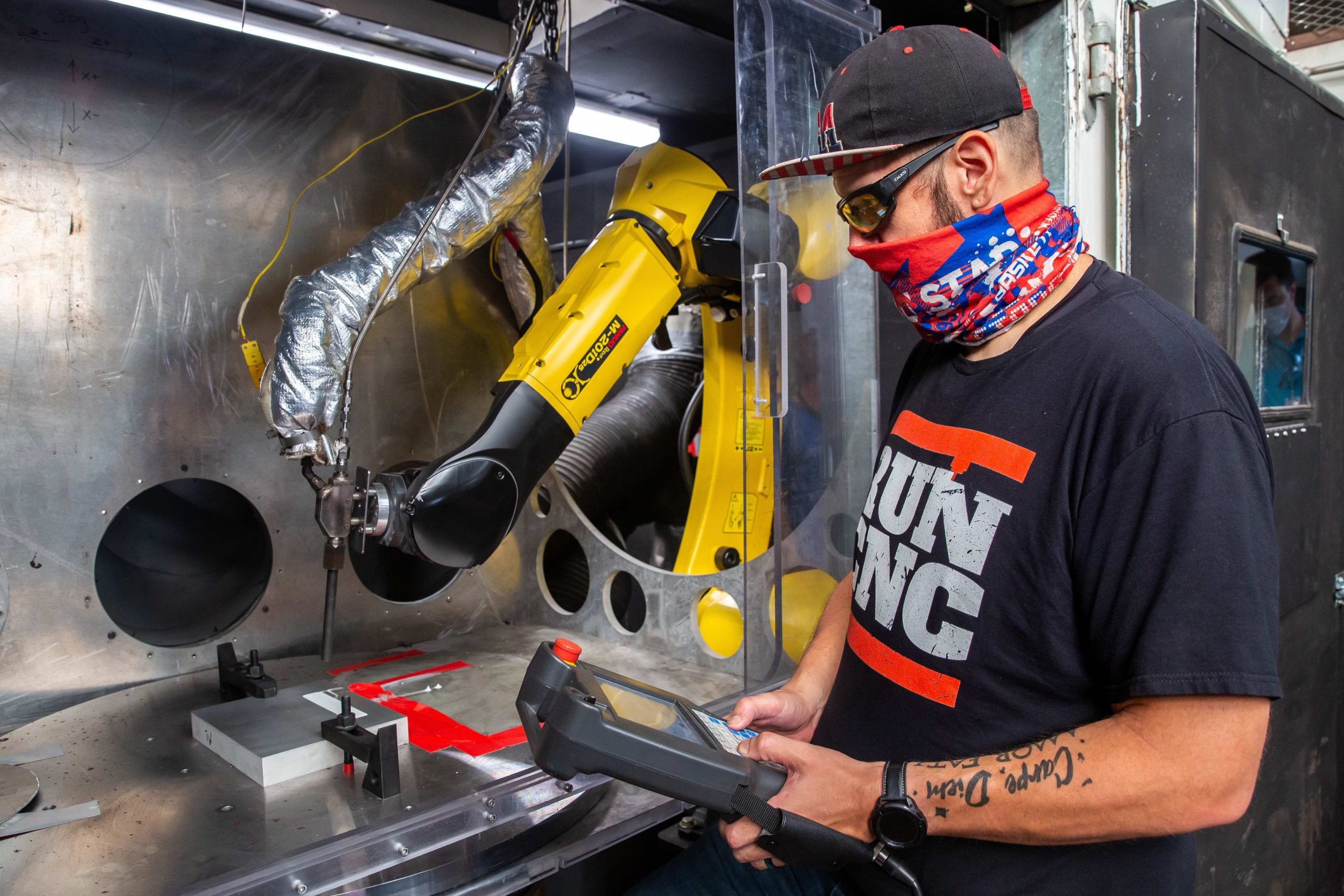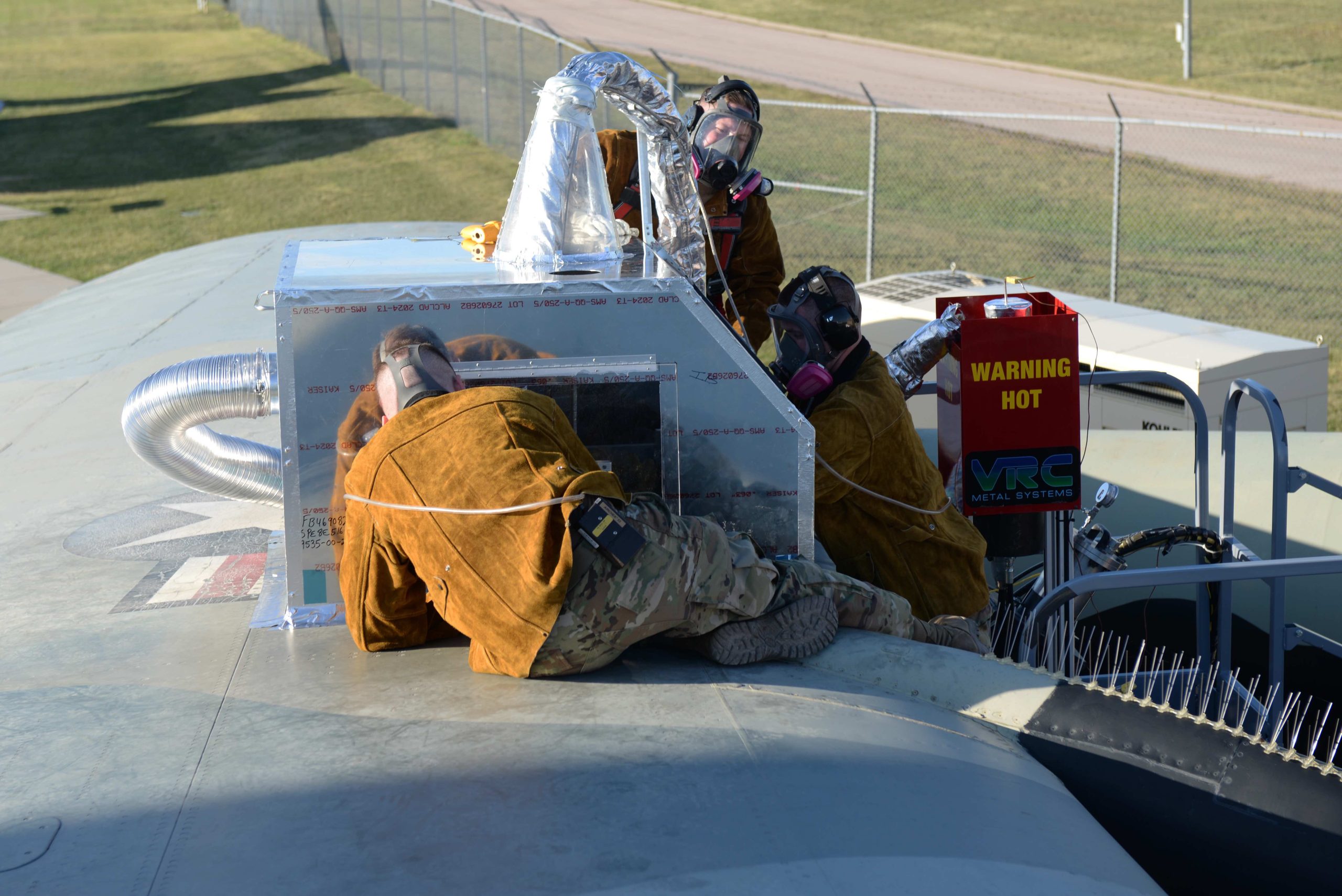
SAN DIEGO, Calif. – If a part breaks on a ship or submarine sailing in a conflict zone or moored at its homeport, the fix just might be done with a portable welder or a mobile workshop set up on the pier in an unconventional way, using an innovative technology known as “cold spray.”
Cold spray uses a highly-pressurized gas that fires heated metal powder at supersonic speed to lay metal onto a surface. It’s not cold, per se, but at 800 degrees Celsius or so is far cooler than traditional “hot” welding.
The technology uses a process called high deposition rate additive manufacturing. It uses various types of powders – ranging from aluminum to titanium as well as specialty powders – for hard coatings as well as customized repairs including aircraft panel fasteners, damaged pipes and shafts, corroded impellers, joint leaks and valve actuators, according to the company. It can replace worn metal coatings with metal that’s at least as strong and hard as the original coating, officials say.
Cold-spray technology isn’t new – it was developed in Russia in the 1980s – but has become a growth industry garnering great interest and use by the military services grappling with parts shortages, clogged supply lines and demands for rapid-repair capabilities for deployed forces.
“[Cold spray] is one that we are really going after,” Rear Adm. Jason Lloyd, U.S. Naval Sea Systems Command’s chief engineer, said last week during the American Society of Naval Engineers’ annual Fleet Maintenance & Modernization Symposium.
The Navy has already seen months shaved off specific ship repairs using the technology, but the equipment can be prohibitively expensive. Now the Navy is developing a unique partnership with a company that’s developed smaller portable and deployable cold-spray systems that can be rapidly fielded and deployed.
“It’s a real advantage for getting after some repairs – not all – but it gives shipyards and local repair the option of using a different repair method,” said Lloyd, who also serves as NAVSEA’s deputy commander for ship design, integration and naval engineering (SEA-05). The Navy first used cold spray in 2019 at Norfolk Naval Shipyard, Va., and “the shipyards have been using them quite a bit,” he said.

To defray the high cost of the equipment, the Navy is investigating using the repair capability as a service provided by a commercial partner. The as-a-service arrangement might provide an entry point for private yards and smaller businesses that otherwise couldn’t afford the investment.
“This is going to take a monumental will to get where we need to go,” he said. “We have near-term competitors that we have not had in my time in the Navy.”
The Navy has partnered with VRC Metal Systems, a Box Elder, S.D.-based company that specializes in cold-spray technology, to create “pop-up” production cells within 90 days, which will be located near ports. The company will use equipment leased by the Navy to do repairs in three weeks or less – and at no cost to the customer.
The Navy is funding a handful of pop-up cells, including one in Chesapeake, Va., with congressional plus-up money “to figure out how to get technology out to industry.” As envisioned, the cold-spray production cells would be used for a few years through the life of the contract – it operates as a “capability as a service” model – and then the company could potentially continue to use the equipment and sell the service as a business. The contract to rapidly field cold-spray technology was developed under the Navy’s Small Business Innovation Research program, according to the U.S. General Services Administration, which worked with NAVSEA on the idea.
“The hope – ‘if you build it, they will come’ – is that after two years, we will give that over to a contractor who wants to take over the cold-spray pop-up in an area [where it] can sell that as a service,” Lloyd said. He joined in a Sept. 8 ribbon-cutting ceremony marking the San Diego pop-up cell in National City, not far from the U.S. Pacific Fleet’s San Diego waterfront home. “The government,” he said, “is investing in trying to help build this industrial base back.”
Focus on Fleet Fixes

VRC, one of a handful of companies using cold-spray tech, has developed a trio of systems that can be scaled depending on the type and scope of repairs. On Sept. 6, the Army awarded VRC a five-year contract worth $50 million for its cold-spray technology.
Its larger stationary system in San Diego is called C.A.M.P. Site, with a robotic arm that does the programmed work inside a 400-square-foot cold-spray booth with 3-inch-thick walls to dampen the loud machinery. A bank of exterior cameras monitor the work inside. A dust collector exchanges the air 6.5 times every minute during a spray repair session. “These are configurable,” said Dan Stanley with the NAVSEA 05T Technology Office, noting one shipyard has a larger booth to accommodate repair of bigger parts.
The company also has developed smaller, portable setups that expeditionary and manageable for sailors or Marines who will be trained to use the system in the field. “The Navy’s developed training based on the VRC Systems,” Jeffrey Campbell, the NAVSEA cold-spray program manager, said during a tour at the San Diego pop-up. “Some of the other services have different systems, so we’re looking at how do we standardize the operator and the engineer training so any service can use that, and the specific equipment.” Training is one of the topics of a Pentagon-led working group meeting this week, Campbell said.
VRC Raptor is a deployable, ruggedized, trailer-portable system that uses cold spray by a handheld nozzle or by a remotely operated robot. It was used pierside in April on USS Essex (LHD-2) to repair a worn rudder stock – an 18-foot, 14-ton part that wasn’t available for the amphibious assault ship.
“We used cold spray there and we effected those repairs,” Lloyd told the ASNE audience. The corrosion was found while replacing bearings, but the traditional repair would have added 24 days of dry docking and risked potential warping that can happen with hot welding.
The smaller system, called VRC Dragonfly, helped prompt NAVSEA to resolve corrosion found on the Virginia-class submarine USS Rickover (SSN-795). Traditional repair to the submarine operating rod sealing surface would have meant a five-month unscheduled period in the dry dock and required removing the shaft and other parts, Lloyd said. “They were going to have to pull the submarine into dock and do a weld repair to it, heat treat it and put it back in.”
Could the part be repaired underway? The idea surfaced during regular discussions Lloyd said he has with NAVSEA and chief engineers about turning new technologies into something portable and, in the case of the repair aboard Rickover, small enough to fit through a submarine hatch.
So the Navy worked with VRC Metal Systems to develop the mobile system over the course of a month. It had to be small enough to be placed aboard Rickover, and there were safety considerations such as ensuring excess nitrogen wasn’t dumped in the boat and that sailors wore sufficient hearing protection, said Dan Stanley, with NAVSEA (05T) Technology Office. “It took us four days just to get the infrastructure set up,” Stanley said. “Ten minutes for one spray, two for another.”
The repair was completed in eight days in November 2022. “All this time, the boat stayed in the water,” Lloyd said. “What a time saver.”
“That one problem with a shaft could take a submarine into dock for five months,” he added. “Instead, we got it done in five days.”
Short-term repairs

Officials expect to see more time and money saved as more cold-spray technology is fielded and used to tackle more ship and submarine repairs without waiting for a docking period or deferring repairs, perhaps at risk, until a fix or replacement part arrives. Last week, the $2 million San Diego Cold Spray Pop-Up Cell, built in a nondescript industrial building two miles from the Navy’s piers at its 32nd Street naval station, officially opened for business.
“The pop-up cell model gives you the ability to get the stuff out there, use the capabilities,” said Campbell, “and it’s a win-win for the government and the vendor. We’re paying for it, but we’re getting the benefit of it.”
The concept is meant to incentivize industry. “We’re paying for the capability to go and repair parts,” Stanley said. The Chesapeake pop-up cell has been “busy with one ship. We know if there’s enough stuff coming in, we could entertain doing a second ship and just keep running.” Public shipyards, he added, “either have or are getting this capability.”
“The idea is as we’re standing up the NAVSEA capability, everybody is playing with the same equipment,” Stanley said. So someone having an issue “can reach out to the other sites, hey, here’s my specific problem … and you can have that instantaneous validation.” He held up a mock-up of a valve on a motor shaft on the USS George H.W. Bush (CVN-77) in 2020, an earlier repair that helped demonstrate the technology.
Doing rapid repairs locally through a pop-up for customers from a business, regional maintenance center or larger shipyard also saves money and parts by using additive manufacturing. “For taxpayers, you’re at a third of the cost to replace that” part, said Tim Gellerson, VRC Group chief strategy officer. “From a warfighter’s perspective, I’m not waiting on a part. My ship is ready to go when it needs to be ready to go when I’m not waiting on the supply system to try and mill a part.”
It also creates a pool of items – some costing six figures, like a Mk82 missile director elevation shaft – that would have been scrapped or tossed but now are shelved for repair or reuse.
Ron Morrison, the National City mayor and Army veteran, joined in the grand opening that marked a two-year effort that he says complements the area’s shipping, maritime and industrial supply businesses and the nearby $100 million repair facility and dry dock that Austal USA opened earlier this year. “Now when they’re refitting, instead of sending them up to Bremerton (Wash.) or some place else, how much more important is it to have all these assets right here locally,” Morrison said, noting “there’s all kinds of different things that compliment the Navy perfectly.”
A topic of recent discussions with local Navy commanders wasn’t about how many ships were in port “but how many of them are ready for service, and so much of it is they’re waiting on the supply chain,” he said. “So being able to turn around a ship needing some repair in days, that’s amazing.”
After talking up the new cold-spray tech during the ASNE conference, Lloyd and other Navy and VRC officials said they expect work to stream into the pop-up and other sites at a good clip as word spreads. Already, they’ve been flooded with requests from Littoral Combat Ship port engineers, whose aluminum boats have grappled with problems of cracking. “So could we use this to address the aluminum cracking problems on LCS? So they’re pretty excited about it,” said Lloyd.





